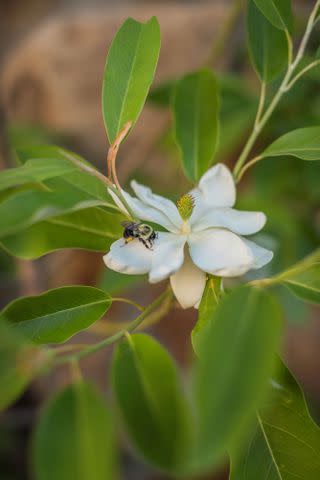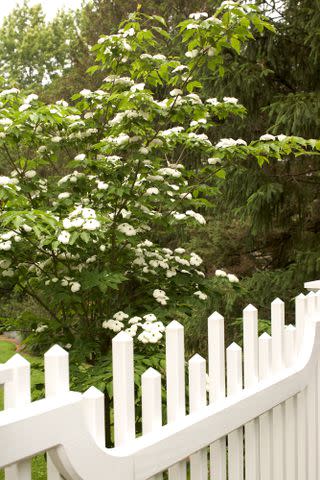How to Plant and Grow a Black Gum Tree
This native shade tree with brilliant fall color is a food source and habitat for wildlife.
There are many reasons to plant and grow a black gum tree (Nyssa sylvatica). For starters, this native tree offers brilliant fall color when its glossy green leaves turn rich shades of yellow, orange, and scarlet. Its flowers attract pollinators in spring, and it is home to a variety of birds, insects, and small animals in summer. The tree’s berries ripen in late summer or fall, feeding songbirds, wild turkeys, bears, and foxes. Varieties that grow to 30 feet are excellent for a small property or planting along a median, while others grow to 60 feet and are stunning landscape specimens or shade trees. Use this guide to find out how to grow and care for a black gum tree in your yard.

Denny Schrock
Where to Plant a Black Gum Tree
Plant a black gum tree where it will have enough space to expand to its mature size without encroaching on nearby structures or other plants. Plant it along a median as a street-side tree or where it can provide shade near a patio or outdoor gathering space. In large landscapes, plant several black gum trees together for a bold fall color show, or pair black gum with native oaks and hickories to create a dynamic wildlife habitat.
How and When to Plant Black Gum Trees
Early spring or fall is the best time to plant black gum. It is often sold as a balled-and-burlapped tree and less commonly as a container-grown plant. Begin planting by digging a hole that is as deep as the root ball is tall and slightly wider than the root ball’s width. Remove the tree from its container or protective wrapping and place it in the planting hole, adding or removing soil so the swollen area at the base of the trunk where the roots extend is level with the surrounding grade. Backfill the planting hole with native soil, firmly tamping it to eliminate air pockets.
Spread a 2-inch layer of mulch over the root zone and water the tree deeply. Continue watering weekly to maintain moist soil in the tree’s root zone. After one growing season, water the tree as needed during long periods of drought.
Tips
Plant a black gum tree where you want it to stay. It has a large taproot and doesn’t transplant well.
Black Gum Tree Care Tips
Black gum is a relatively low-maintenance tree as long as its basic needs are met.
Light
Plant black gum where it will receive at least eight hours of direct sunlight a day. It develops the most intense fall color in bright, sunny growing locations.
Soil and Water
Black gum is an adaptable plant that grows well in moist, well-drained soil, as well as clay or sandy soils. It tolerates heavy, poorly drained soil where many other trees won’t grow. It is known to grow in standing water for short periods. Black gum requires regular watering during the first year after planting. After it establishes a root system, it tolerates extended dry periods.
Temperature and Humidity
Black gum trees grow well in a range of climates. They grow hot, dry areas and in cold, damp environments.
Fertilizer
Black gum doesn’t require fertilizer. It finds the nutrients it needs from the native soil. To encourage robust and rapid growth, spread a 2-inch-thick layer of compost over the tree’s root zone annually in spring. The compost will decompose and deliver nutrients to the tree roots.
Pruning
Black gum rarely requires pruning. This slow-growing tree will develop a pleasing, natural shape without regular trimming. If shaping is needed, late winter or early spring is the best time to prune the tree, when its overall form is easy to see because of the leafless branches. Remove dead, diseased, or damaged branches whenever you notice them.
Pests and Problems
Black gum isn’t usually affected by severe pest or disease problems. At times, they may encounter cankers, leaf spots, rust, scale, tupelo leaf miners, or black twig borers, but these pests and diseases are rarely fatal. New cultivars provide some resistance to leaf spot and some other pests and diseases.
How to Propagate Black Gum Trees
Black gum trees can be propagated by seeds, but the process is somewhat complicated, and the results can be disappointing. Harvest a single seed from each seedpod when they appear in early autumn. Soak the seeds in water for 24 hours and then place them in an unheated area for 60-90 days for cold stratification.
Fill 4-inch pots that have drainage holes with a mixture of half sand and half seed-starting mix. Place one or two seeds in each pot and cover with 1/4-inch of planting medium. Not all the seeds will germinate, so prepare more pots than you need.
Place the pots in an area where the temperature is 75°F-85°F and the pots receive bright, indirect or filtered light for germination. After the seeds germinate and have two true leaves, transplant the seedlings into larger pots.
Related: The 11 Best Seed-Starting Soil Mixes of 2023
Types of Black Gum
‘Fire Master’
Nyssa sylvatica ‘Fire Master’ is a large black gum tree with shiny green leaves that turn bright red in the fall. It grows 50-60 feet tall and up to 25 feet wide and tolerates a wide range of growing conditions. This stunning landscape tree adds beauty to a home landscape for many years. Zones 4-9
‘Red Rage’
Nyssa sylvatica ‘Haymanred,’ sold as ‘Red Rage’, has a pyramidal form and dark green leaves. It offers good resistance to leaf spot. It grows 35-50 feet tall and spreads to 30 feet. Zones 4–9
‘Tupelo Tower’
Unlike most black gum trees, Nyssa sylvatica ‘Tupelo Tower’ has a tight, upright columnar form. It grows 30 to 40 feet tall and 10 to 15 feet wide. Its foliage turns deep yellow, orange, and scarlet red in autumn. Zones 4–9
‘Wildfire’
Nyssa sylvatica ‘Wildfire’ offers bold fall color and excellent leaf spot resistance. The new foliage is bright red, maturing to shiny green before returning to bright crimson in the fall. The tree grows to 50 feet tall and 30 feet wide. Zones 4–9
Black Gum Companion Plants
Black gum often grows alongside native oaks and hickories in nature, but other good planting companions for home gardeners are available.
Magnolia

Bob Stefko
Magnolias announce spring has arrived with showy blooms, sometimes even before the tree has leaves. You can find a magnolia adapted to just about every growing zone, and they're available in sizes from small shrubs to tall trees.
Dogwood

Peter Krumhardt
Dogwoods are available in a wide variety of colors, shapes, and sizes. They add structure and color to the landscape for most of the year. The show begins with four-petal blooms from spring into summer, followed by bright red and orange foliage in the fall. Winter brings bright red fruit for a final splash of color.
Carolina Allspice

Carolina allspice qualifies as an all-star choice for urban, suburban, and native landscapes. It grows to considerable width at a moderate rate, about 12 to 18 inches per year. This native shrub offers multi-seasonal interest.
Frequently Asked Questions
Where is black gum native?
Black gum is native from Ontario south along the Eastern United States into Mexico. It has a broad and diverse growing range.
My black gum has spots on its leaves. What is going on?
Although unsightly, leaf spot is rarely problematic to the overall health of the tree. There is no cure or prevention strategy. Let the disease run its course.
How fast do black gum trees grow?
Black gum is a slow-growing tree. Expect it to grow about 12 inches per year.
For more Better Homes & Gardens news, make sure to sign up for our newsletter!
Read the original article on Better Homes & Gardens.
